ECO mode AUDI A8 2013 Owner's Manual
[x] Cancel search | Manufacturer: AUDI, Model Year: 2013, Model line: A8, Model: AUDI A8 2013Pages: 318, PDF Size: 79.34 MB
Page 111 of 318
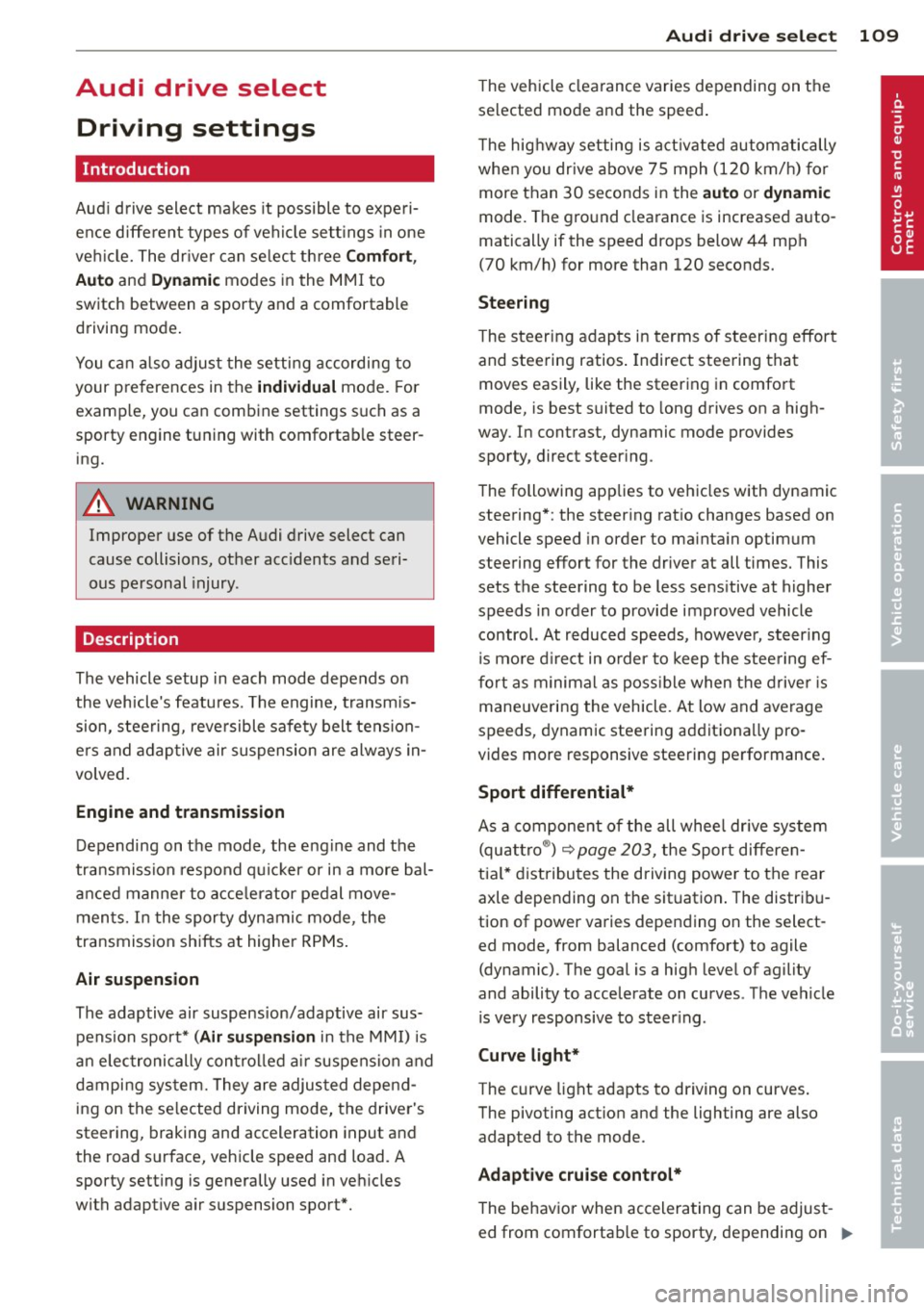
Audi drive select Driving settings
Introduction
Aud i drive select makes it possible to experi
ence different types of vehicle settings in one
veh icle. The driver can select th ree
Comfort,
Auto
and Dynamic modes in the MMI to
switch between a sporty and a comfortable
driving mode.
You can also adjust the setting according to
your preferences in the
individual mode. For
examp le, you can combine settings such as a
sporty engine tuning with comfortab le steer
ing.
A WARNING
Improper use of the Audi drive select can
cause collisions, other acc idents and seri
ous personal injury .
Description
The vehicle setup in each mode depends on
the vehicle's features. The engine, transm is
sion, steering, reve rsible safety belt tension
ers and adaptive air suspension are always in
volved.
Engine and transmission
Depending on the mode, the engine and the
tra nsmission respond quicker or in a more bal
anced manne r to acce lerator pedal move
ments. In the sporty dynamic mode, the
transmission shifts at higher RPMs .
Air suspension
The adaptive air suspension/adaptive air sus
pension sport*
( Air suspension in the MMI) is
an electronically con trolled air suspension and
damping sys tem. They are adjusted depend
ing on the selected driving mode, the drive r's
steering, braking and acceleration input and
the road s urface, vehicle speed and load. A
sporty setting is generally used in vehicles
with adaptive air suspension sport*.
Audi drive select 109
The vehicle clearance varies depending on the
selected mode and the speed .
T he hig hway setting is activated automatically
when you drive above 75 mph (120 km/h) for
more than 30 seconds in the
auto or dynamic
mode. The ground clearance is increased auto
matically if the speed drops below 44 mph
(70 km/h) for more than 120 seconds.
Steering
The steering adapts in terms of steering effort
and steering ratios . Indirect stee ring that
moves easily, like the steering in comfort
mode, is best suited to long drives on a high
way . In contrast, dynamic mode provides
sporty, direct steer ing .
The following applies to vehicles with dynamic steering* : the steering ratio changes based on
vehicle speed in order to ma inta in optimum
steering effort for the driver at all times. This
sets the steering to be less sens itive at higher
speeds in order to provide improved vehicle
control. At reduced speeds, however, steer ing
is mo re direct in order to keep the steering ef
fort as minimal as possible when the driver is
maneuvering the vehicle. At low and average
speeds, dynamic steering additiona lly pro
vides more responsive steering performance.
Sport differential*
As a component of the all whee l dr ive system
(quattro ®)
<:!) page 203, the Sport differen
tia l* distributes the driving power to the rear
axle depending on the situation . The distribu
tion of power varies depending on the select
ed mode, from balanced (comfort) to agile
(dynamic). The goal is a high level of agility
and ability to accelerate on curves . The vehicle
is very responsive to steering.
Curve light*
The curve light adapts to driving on curves.
The pivoting act ion and the lighting are also
adapted to the mode.
Adaptive cruise control*
The behavior when accelerating can be adjust
ed from comfortab le to sporty, depending on .,..
Page 117 of 318
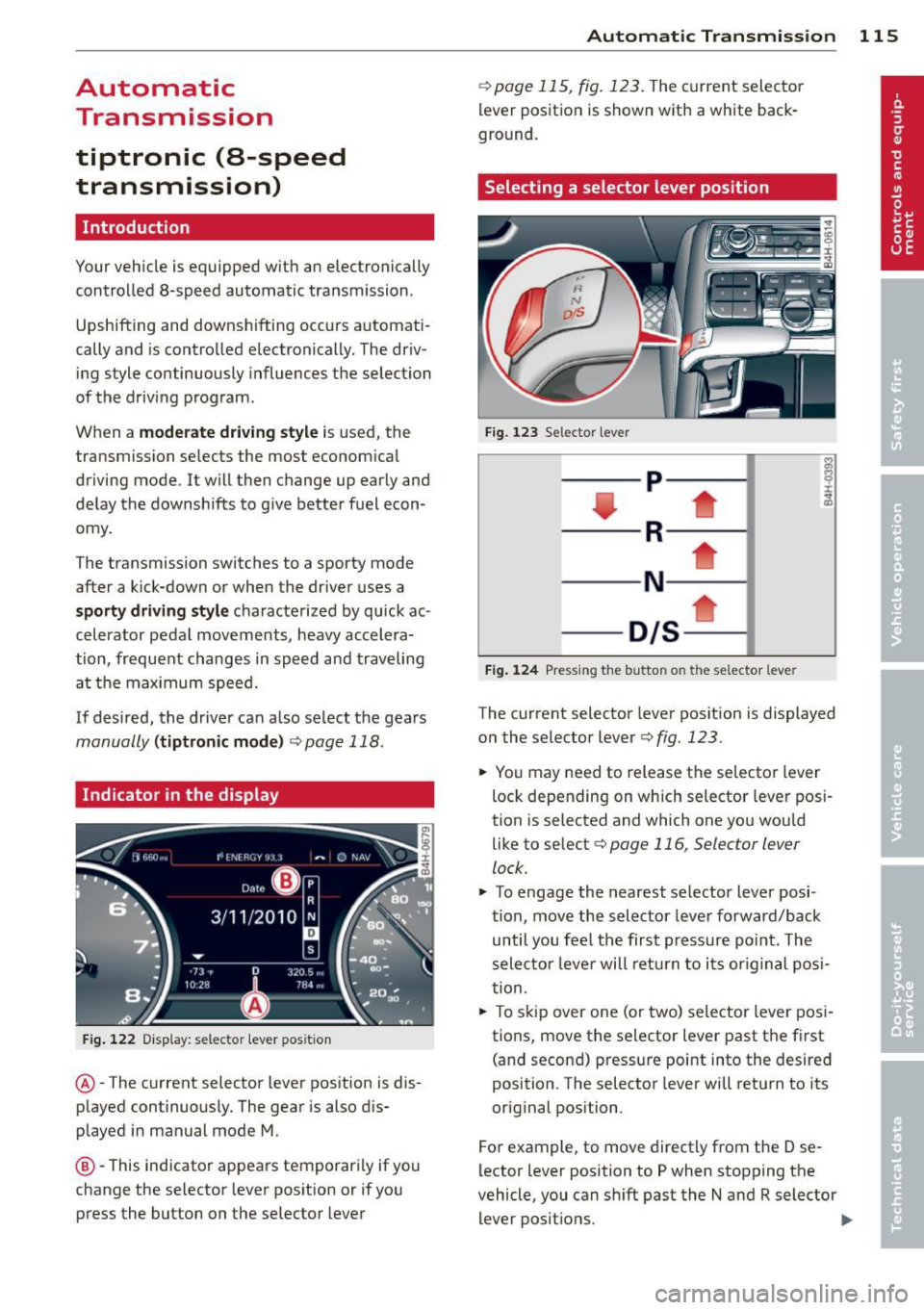
Automatic Transmission
tiptronic (8-speed
transmission)
Introduction
Your vehicle is equipped with an electronically
controlled 8-speed automatic transmission .
Upshifting and downshifting occurs automati
cally and is controlled electronically. The driv
ing style continuously influences the selection
of the driving program.
When a
moderate driving style is used, the
transmission selects the most econom ical
driving mode. It will then change up early and
delay the downshifts to give better fuel econ
omy.
The transmission switches to a sporty mode
after a kick-down or when the driver uses a
sporty driving style characterized by quick ac
celerator pedal movements, heavy accelera
tion, frequent changes in speed and traveling
at the maximum speed.
If desired, the driver can also select the gears
manually (tiptronic mode) ¢ page 118.
Indicator in the display
Fig. 122 Display: selector lever pos it ion
@ -The current selector lever position is dis
played continuously. The gear is also dis
played in manual mode M.
@-This indicator appears temporarily if you
change the selector lever position or if you
press the button on the selector lever
Automatic Transmission 115
¢ page 115, fig. 123 . The current selector
lever position is shown with a white back
ground.
Selecting a selector lever position
Fig. 123 Selector lever
---R--- -t
--- N---_..
- D/S--
Fig. 124 Pressing the button o n the selector leve r
The current selector lever position is displayed
on the selector lever¢
fig. 123.
.. You may need to release the selector lever
lock depending on which selector lever posi
tion is selected and which one you would
like to select ¢
page 116, Selector lever
lock .
.. To engage the nearest selector lever posi
tion, move the selector lever forward/back
until you fee l the first pressure point. The
selector lever will return to its original posi
tion .
.. To skip over one (or two) selector lever posi
tions, move the selector lever past the first (and second) pressure point into the desired
position. The selector lever will return to its
original position.
For example, to move directly from the D se
lector lever position to P when stopping the
vehicle, you can shift past the N and R selector
lever positions . ..,.
Page 118 of 318
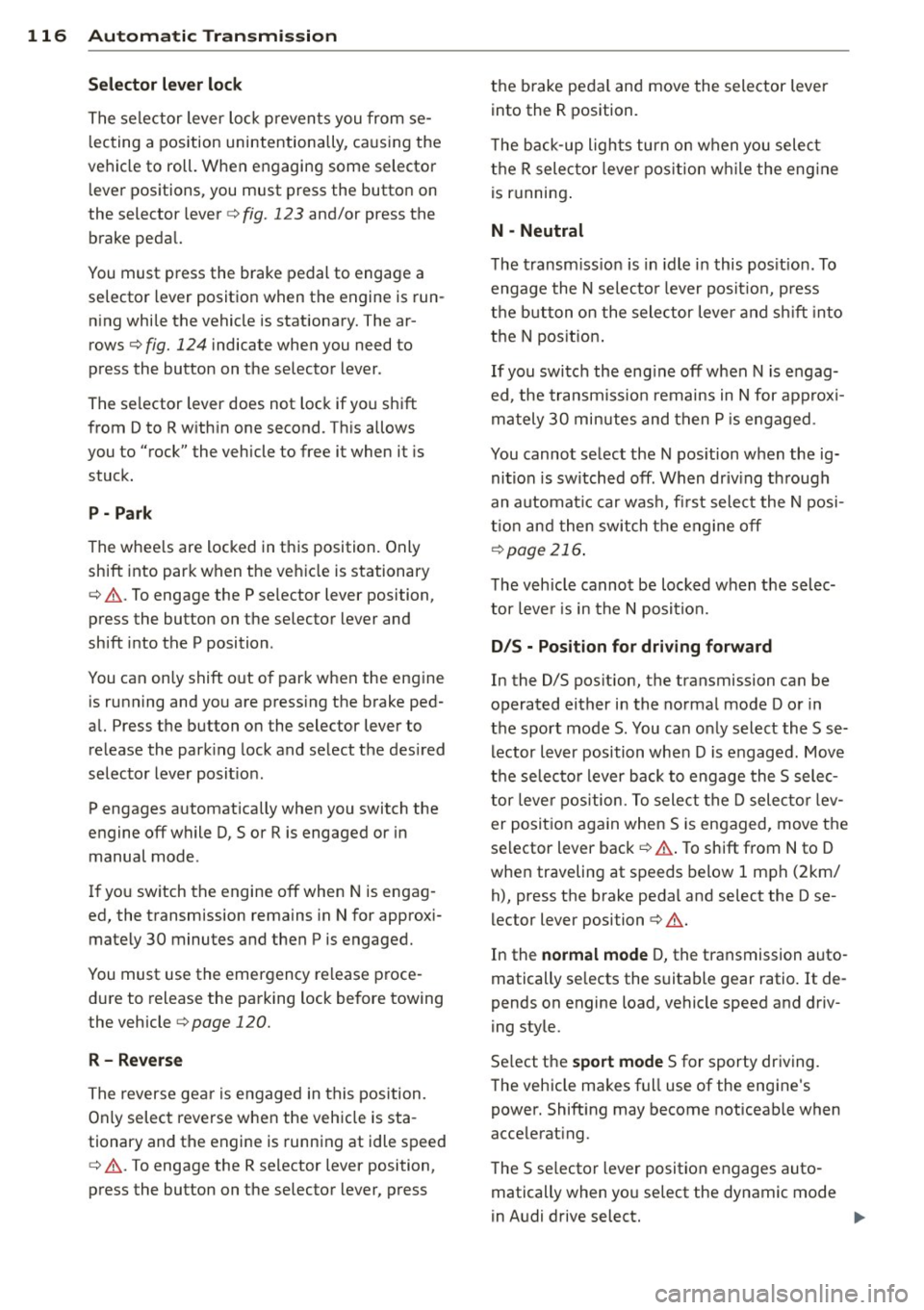
116 Automatic Transmission
Selector lever lock
The selector lever lock prevents you from se
l ecting a position unintentionally, causing the
vehicle to roll. When engaging some selector lever positions, you must press the button on
the selector lever<=>
fig. 123 and/or press the
brake pedal.
You must press the brake pedal to engage a
selector lever position when the engine is run
n ing while the vehicle is stationary. The ar
rows¢
fig. 124 indicate when you need to
press the button on the selector lever.
The selector lever does not lock if you shift
from D to R within one second . This allows
you to "rock" the vehicle to free it when it is
stuck.
P - Park
The whee ls are locked in this position. Only
shift into park when the vehicle is stationary
¢ & .To engage the P selector lever position,
press the button on the selector lever and
shift into the P position.
You can only shift out of park when the eng ine
is running and you are pressing the brake ped
al. Press the button on the selector lever to
release the park ing lock and select the des ired
selector lever posit ion.
P engages automatically when you switch the
engine off while D, Sor R is engaged or in
manual mode.
If you switch the engine off when N is engag
ed, the transmission remains in N for approxi
mately 30 minutes and then Pis engaged.
You must use the emergency release proce
dure to release the parking lock before towing
the vehicle
¢ page 120.
R - Reverse
The reverse gear is engaged in this position.
Only select reverse when the vehicle is sta
tionary and the engine is running at idle speed
¢ & .To engage the R se lector lever position,
press the button on the selector lever, press the
brake pedal and move the selector lever
into the R position.
T he back-up lights turn on when you select
the R selector lever position while the engine
is running .
N -Neutral
The transmission is in idle in this position. To
engage the N selector lever position , press
the button on the selector lever and shift int o
the N position.
If you switch the engine off when N is engag
ed, the transmission remains in N for approxi
mately 30 min utes and then Pis engaged.
You cannot select the N position when the ig
nition is switched off . When driving through
an automat ic car was h, first select the N posi
tion and then switch the engine off
¢page 216.
The vehicle cannot be locked when the selec
tor leve r is in the
N position.
D/S - Position for driving forward
In the D/S pos ition, the transmission can be
operated either in the normal mode Dor in
the sport mode S. You can only select the S se
lector lever position when Dis engaged. Move
the selecto r lever back to engage the S selec
tor lever position. To select the D selector lev
er position again when S is engaged, move the
selector lever back¢& . To shift from
N to D
when traveling at speeds below 1 mph (2km/
h), press the brake pedal and select the D se
lector lever position ¢
&.
In the normal mode D, the transmission auto
matically selects the suitable gear ratio.
It de
pends on engine load, vehicle speed and driv
ing style.
Select the
sport mode S for sporty driving.
T he vehicle makes full use of the engine's
power. Shift ing may become noticeab le when
acce lerat ing.
The S selector lever position engages auto
matically when yo u select the dynamic mode
in Audi drive select.
...
Page 125 of 318
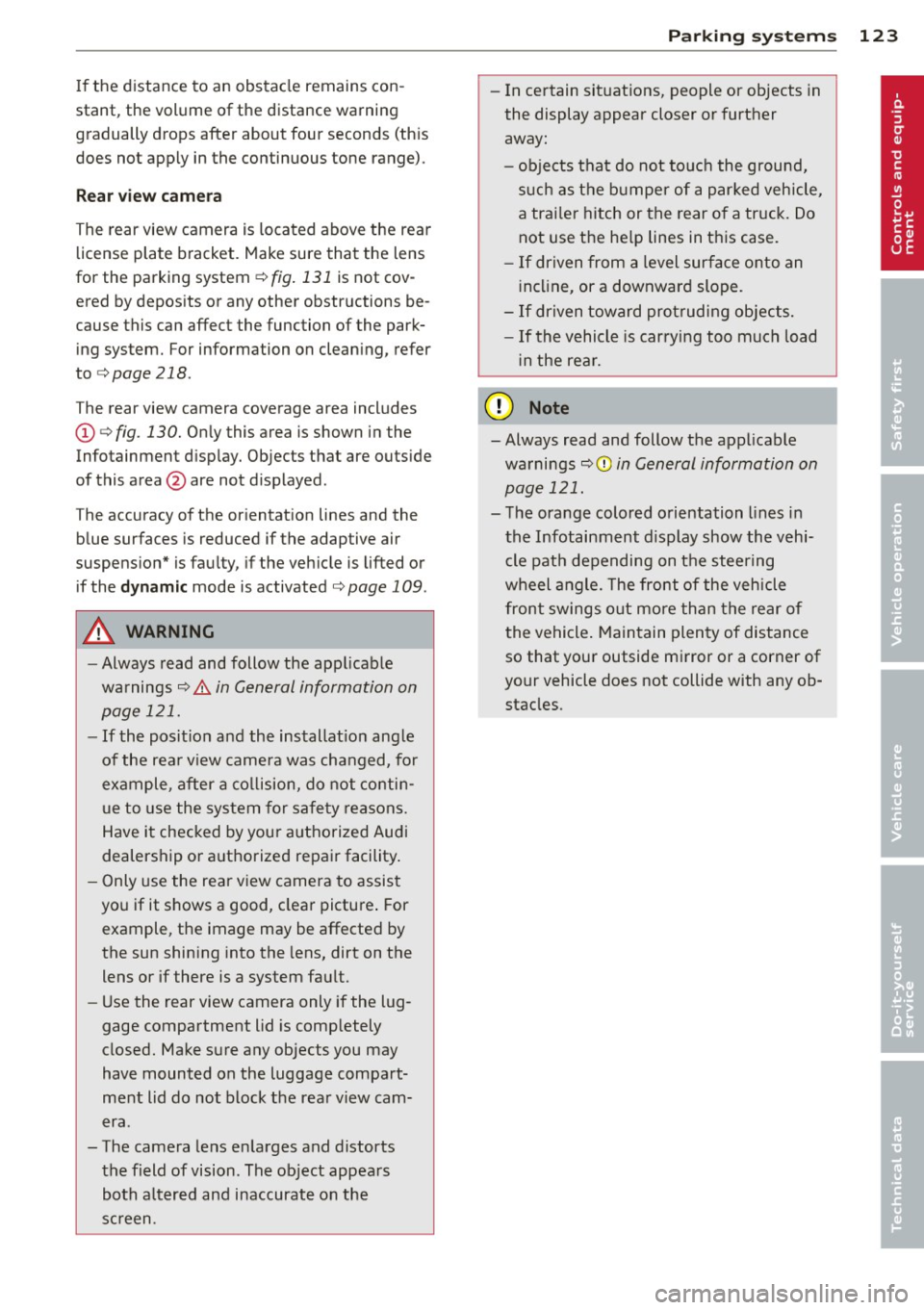
If the distance to an obstacle remains con
stant, the volume of the distance warning
gradually drops after about four seconds (this
does not apply in the continuous tone range).
Rear view camera
The rear view camera is locat ed above the rear
license plate bracket. Make sure that the lens
for the parking system
r::;, fig. 131 is not cov
ered by deposits or any other obstructions be
cause this can affect the function of the park
ing system. For information on clean ing, refer
to
c;, page 218.
The rear view camera coverage area includes
(Dr::;, fig. 130. Only this area is shown in the
Infotainment display. Objects that are outside
of this area @are not displayed.
The accuracy of the orientation lines and the
blue surfaces is reduced if the adaptive air
suspens ion* is faulty, if the veh icle is lifted or
if the
dynamic mode is activated r::;, page 109.
A WARNING
-Always read and follow the applicable
warnings
r::;, &. in General information on
page 121.
- If the position and the installation angle
of the rear view camera was changed, for
example, after a collision, do not contin
ue to use the system for safety reasons.
Have it checked by your authorized Audi
dealership or authorized repair facility.
- Only use the rear view camera to assist
you if it shows a good, clear picture. For
example, the image may be affected by
the sun shining into the lens, dirt on the
lens or if there is a system fault.
- Use the rear view camera only if the lug
gage compartment lid is comp letely
closed. Make sure any objects you may
have mounted on the luggage compart
ment lid do not block the rear view cam
era .
- The camera lens enlarges and distorts the field of vision. The object appears both altered and inaccurate on the
screen.
Parking systems 123
-In certain situations, people or objects in
the display appear closer or further
away:
- objects that do not touch the ground,
such as the bumper of a parked vehicle,
a trailer hitch or the rear of a truck. Do
not use the help lines in this case.
- If driven from a level surface onto an
inclin e, or a downward slope.
-If driven toward protruding objects.
- If the vehicle is carrying too much load
in the rear.
(D Note
-Always read and follow the applicable
warnings
r::;, (D in General information on
page 121.
- The orange colored orientation lines in
the Infotainment display show the vehi cle path depending on the steering
wheel angle. The front of the vehicle
front swings out more than the rear of
the vehicle. Maintain plenty of distance
so that your outside mirror or a corner of
your vehicle does not collide with any ob stacles.
Page 133 of 318
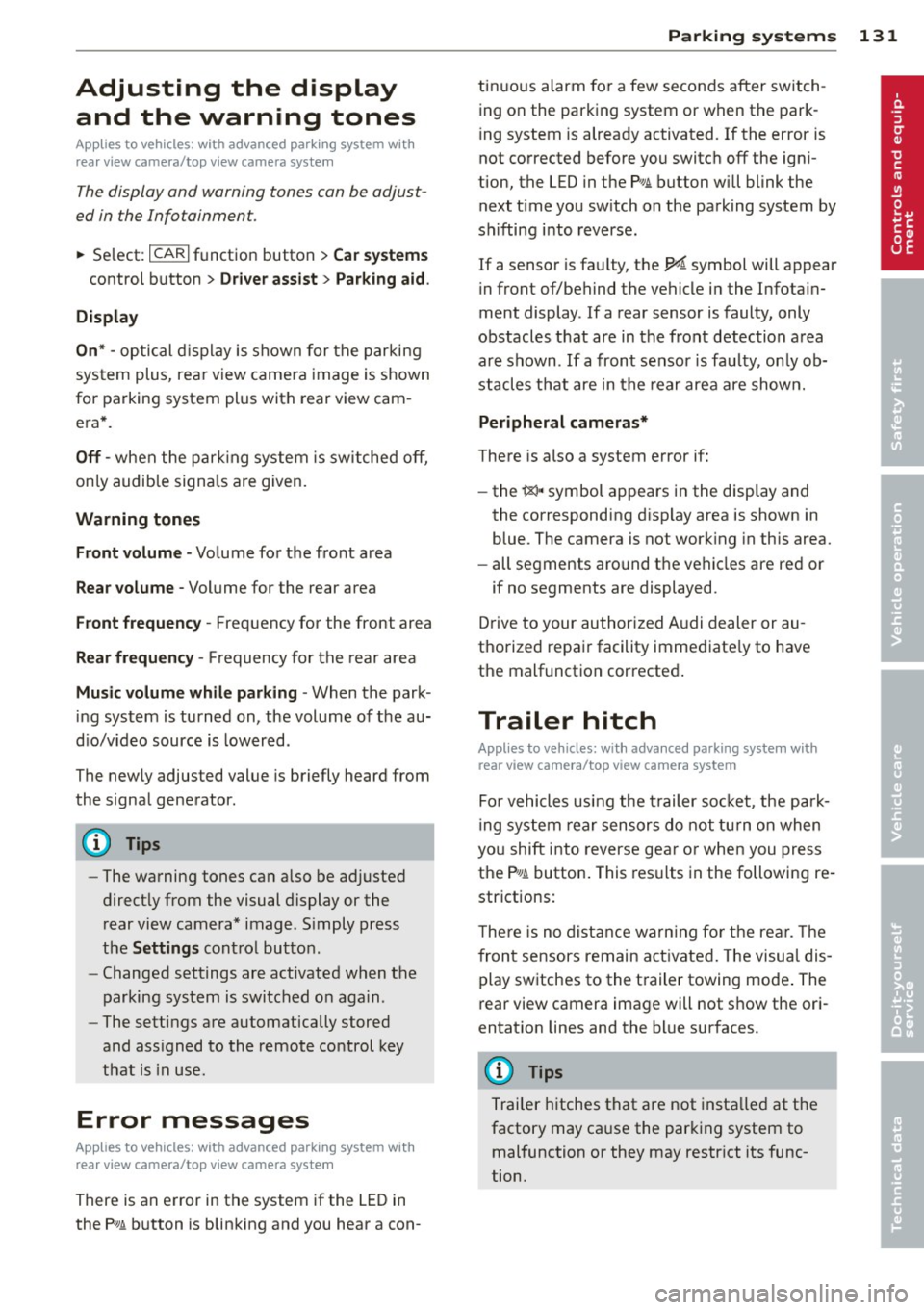
Adjusting the display and the warning tones
App lies to vehicles: with advanced park ing system wit h
rea r view camera/top v iew camera syste m
The display and warning tones can be adjust
ed in the Infotainment.
~ Se lect: ICARI f u nct io n button > Car systems
control button > Driver assist > Parking aid .
Display
On * -
opti cal d isplay is shown for the parking
sys tem plus, rea r view came ra image is shown
for parking system plus with rear view cam
e ra *.
Off -when t he par king system is sw itched off,
on ly audib le sign als are given.
Warning tones
Front volume -
Volume for the fro nt area
Rear volume -Volume for the rear area
Front frequency -Frequency for the front area
Rear frequency -Frequency for the rear area
Music volume while parking -When the park
in g system is turned on, the vol ume of t he au
d io/v ideo source is lower ed.
The new ly adjusted value is briefly heard from
the signa l generator.
@ Tips
- The warning tones ca n also be adjusted
direct ly from the visual display or the
rear view camera* image. S imply press
the
Settings cont ro l but to n.
- Changed settings are activated when the
parking system is switched on aga in.
- The settings are automatically stored
and ass igned to the remote control key
that is in use .
Error messages
Applies to vehicles: with a dvanced park ing system wit h
r ea r view camera/top v iew camera syste m
There is an error in t he system if the LED in
the
?# A button is blinking and you hear a con-
Parking systems 131
tin uous alarm fo r a few seconds after switch
ing on the par king system or when the park
ing system is already activated. If the error is
not corrected before you switc h off the ign i
tion, the LED in the
P,1 1.A button will blink the
next t ime you sw itch on the parking system by
shifting i nto reverse .
If a sensor is fa ulty, the!¾ symbol will appear
in front of/behind the vehicle in the Infota in
ment display . If a rear sensor is faulty, only
obstacles that are in the front detec tion a rea
a re shown . If a front sensor is fau lty, on ly ob
s tacles t hat are in the rear area are shown.
Peripheral cameras*
There is also a system error if:
- the
'(gl ,, symbol appears i n the display and
the corresponding d isp lay area is shown in
blue. The camera is not work ing in this area.
- all segments aro und the vehicles are red or
if no segments are displayed.
D rive to your authorized A udi dealer or au
thorized repair facility immed iate ly to have
the malfunction correcte d.
Trailer hitch
Applies to vehicles: wi th adva nced parking syste m with
rear view ca mera/top view ca mera system
Fo r vehicles using the trailer so cket, the pa rk
i ng sys tem rear sensors do not tu rn on when
you shift i nto reverse gea r or when you press
the
P,#~ button . This res ults in the following re
strictions:
T he re is no dist ance warn ing fo r th e rea r. T he
fron t sensors remain act ivated. The visua l dis
play switches to the t railer towing mode . The
rear view camera image will not show the or i
entat ion lines and the bl ue surfaces.
(D Tips
Trai ler h itches that are not insta lled at the
factory may ca use the park ing system to
malfunction or they may restr ict its func
tion.
Page 135 of 318
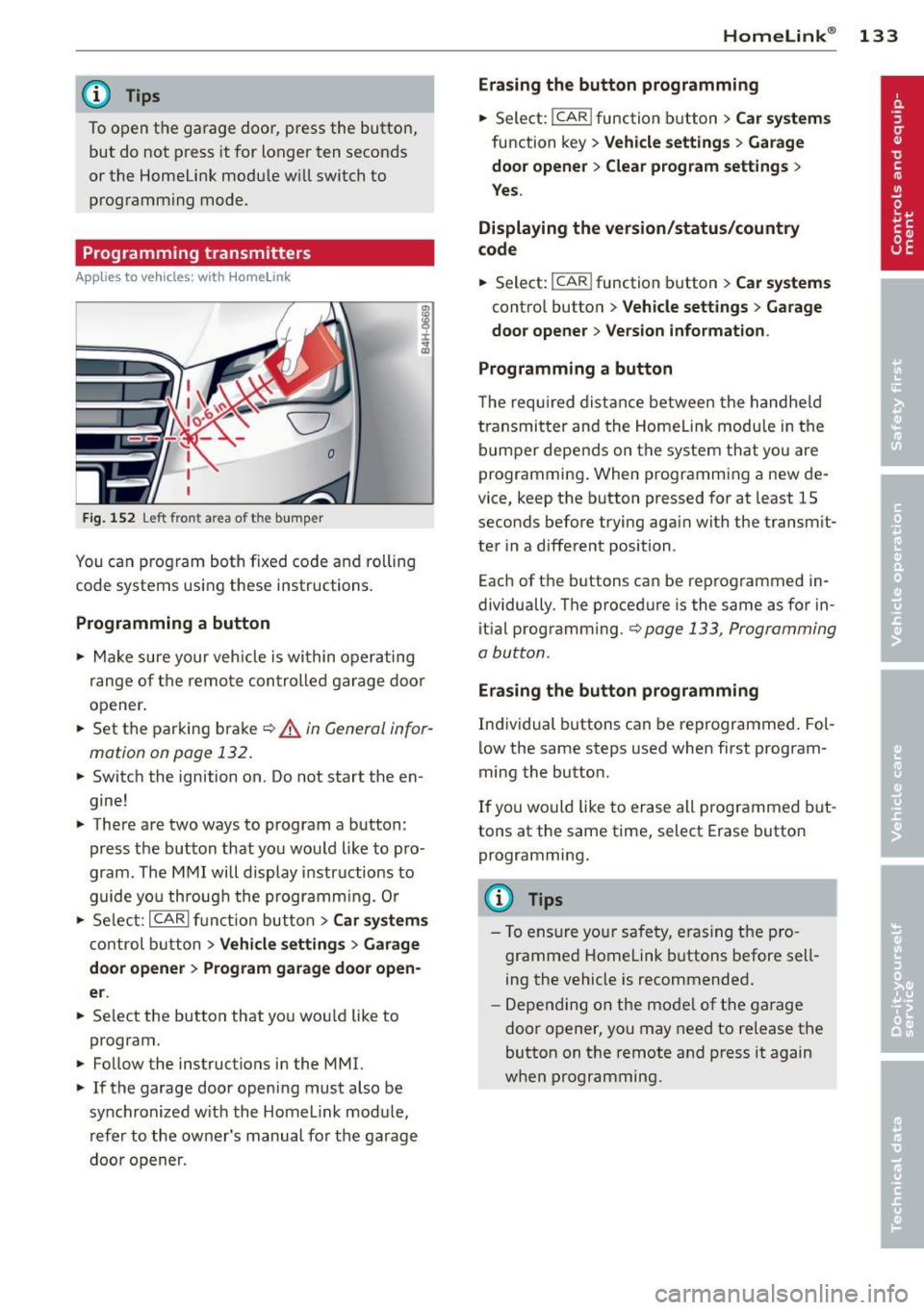
@ Tips
To open the garage door, press the button,
but do not press it for longer ten seconds
or the Homelink modu le w ill switch to
programming mode .
Programming transmitters
Applies to vehicles : wit h Home link
Fig. 152 Left front a rea o f the bum per
You can program both fixed code and rolling
code systems using these instructions .
Programming a button
.,. Make sure your veh icle is within operating
range of the remote control led garage door
opener.
.,. Set the parking brake
¢ A in General infor
mation on page 132.
.,. Switch the ignition on . Do not start the en
gine!
.,. There are two ways to program a button :
press the button that you would like to pro
gram . The MMI will display instructions to
guide you throug h the programm ing. Or
.,. Select :
I CAR I function button > Car systems
control button > Vehicle settings > Garage
door opener> Program garage door open
er .
.,. Se lect the button that you wou ld like to
program.
.,. Follow the instructions in the MMI.
.,. If the garage door opening must also be
synchronized w ith the Homelink module ,
refer to the owner's manual for the garage
doo r opener .
Homelink ® 133
Erasing the button programming
.,. Select: !CAR lfunction button> Car systems
function key> Vehicle settings > Garage
door opener
> Clear program settings >
Yes.
Displaying the version/status/country
code
.,. Select: I CAR ! function button > Car systems
control button > Vehicle settings > Garage
door opener > Version information .
Programming a button
T he requ ired distance between the handheld
transmitter and the Homelink modu le in the
bumper depends on the system that you are
programming . When programming a new de
vice, keep the button pressed for at least 15
seconds before trying again with the transm it
ter in a different position .
Each of th e buttons can be reprogrammed in
dividually . The procedure is the same as for in
itial programm ing .¢
page 133 , Programming
a button .
Erasing the button programming
Individual buttons can be reprogrammed. Fol
low the same steps used when first program
ming the button .
If you would like to erase all prog rammed but
tons at the same time, select Erase button
programming.
@ Tips
- To ensure your safety, eras ing the pro
grammed Homelink buttons before sell
ing the vehicle is recommended.
- Depending on the mode l of the garage
door opener, you may need to release the
button on the remote and press it again
when programming .
Page 165 of 318
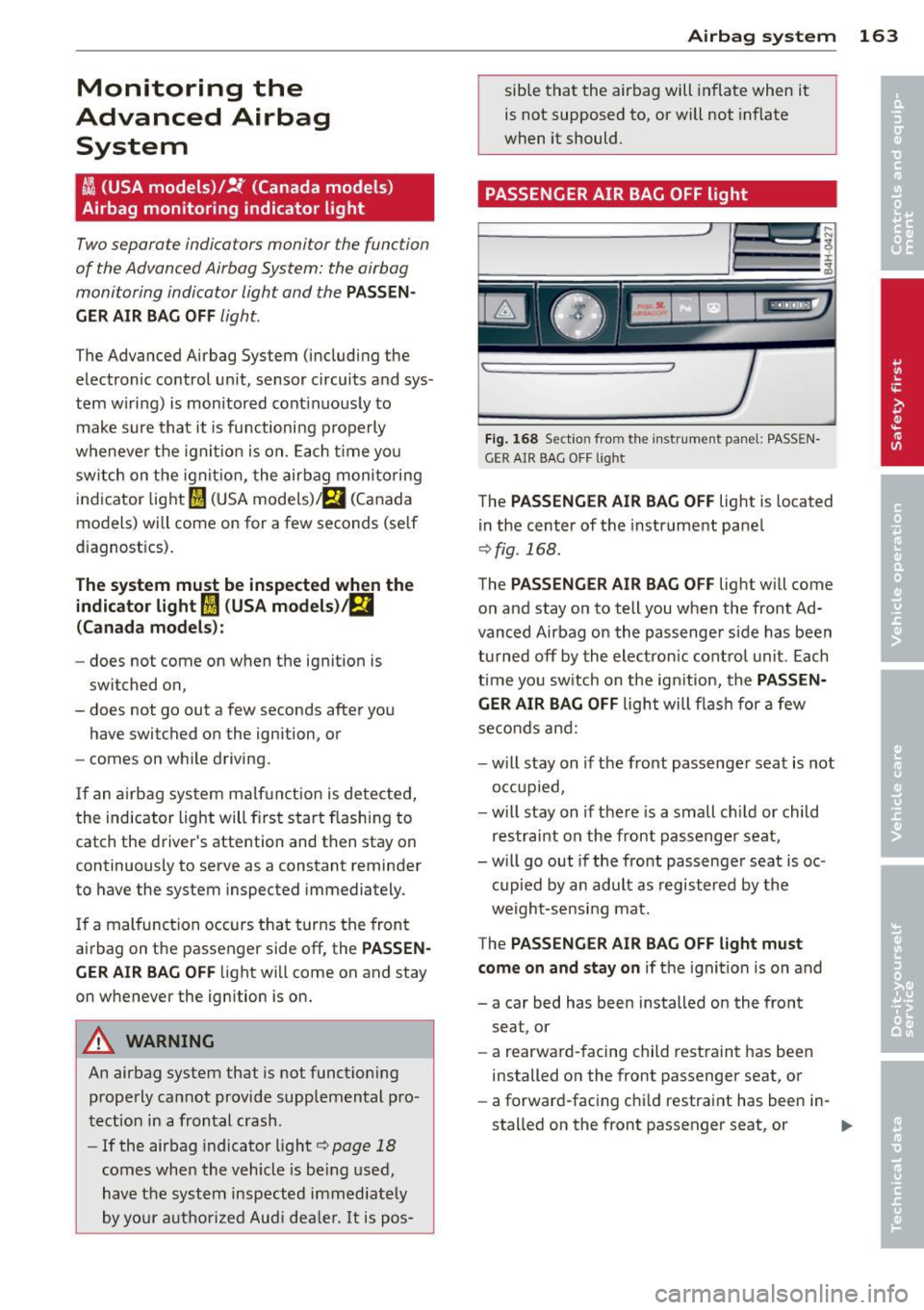
Monitoring the
Advanced Airbag
System
I ( USA models) /!{ (Canada models )
Airbag monitoring indicator light
Two separate indicators monitor the function
of the Advanced Airbag System: the airbag
monitoring indicator light and the
PASSEN
GER AIR BAG OFF
light.
The Advanced Airbag System (including the
electronic control un it, sensor circuits and sys
tem wiring) is monitored continuously to
make sure that it is functioning properly
whenever the ignit ion is on. Each time you
switch on the ignition, the airbag monitoring
indicator light
I (USA models)/ m (Canada
models) will come on for a few seconds (self
diagnost ics).
The system must be inspected when the
indicator light
I (USA models)/fll
(Canada models):
-does not come on when the ignition is
switched on ,
- does not go out a few seconds after you
have switched on the ignition, or
- comes on while driving.
If an airbag system malfun ction is detected,
the indicator light will first start flashing to
catch the driver's attention and then stay on
continuously to serve as a constant reminder
to have the system inspected immediately.
If a malfunction occurs that turns the front
airbag on the passenger side
off, the PASSEN
GER AIR BAG OFF
light will come on and stay
on whenever the ignition is on.
A WARNING
An airbag system that is not funct ioning
properly cannot provide supplemental pro
tection in a frontal crash.
- If the airbag indicator light
c:> page 18
comes when the vehicle is be ing used,
have the system inspected imm ediately
by your autho rized Audi dealer.
It is pos-
Airbag system 163
sible that the airbag will inflate when it
is not supposed to, or will not inflate
when it should.
PASSENGER AIR BAG OFF light
Fig. 168 Sect io n from the instrument pane l: PASSEN·
GER AIR BAG OFF light
The PASSENGER AIR BAG OFF light is located
in the center of the instrument panel
c:>fig . 168.
The PASSENGER AIR BAG OFF light will come
on and stay on to tell you when the front Ad
vanced Airbag on the passenger s ide has been
turned
off by the electron ic control unit. Each
time you switch on the ignition, the
PASSEN
GER AIR BAG OFF
light will flash for a few
seconds and:
- will stay on if the front passenger seat is not
occupied,
- will stay on if there is a small ch ild or child
restraint on the front passenger seat,
- w ill go out if the front passenger seat is oc·
cupied by an adult as registered by the
weight-sensing mat.
The
PASSENGER AIR BAG OFF l ight must
come on and stay on
if the ignition is on and
- a car bed has been installed on the front seat, or
- a rearward-facing child restraint has been
installed on the front passenger seat, or
- a forward-facing child restraint has been in·
stalled on the front passenger seat, or
Page 168 of 318
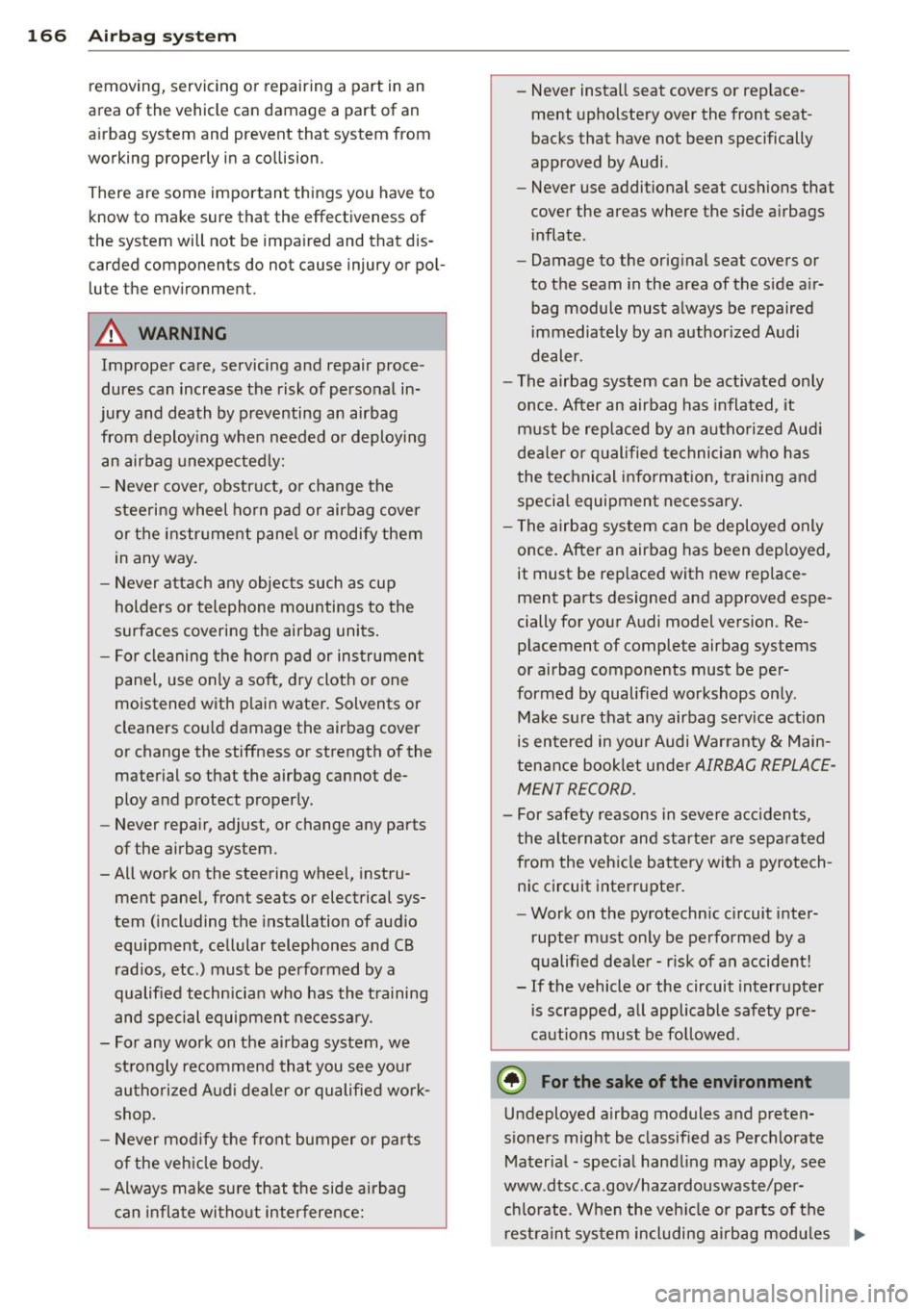
166 Airbag sys te m
removing, servicing or repairing a part in an
area of the vehicle can damage a part of an
a ir bag system and prevent that system from
working properly in a co llision.
There are some important things you have to know to make sure that the effectiveness of
the system will not be impa ired and that dis
carded components do not cause injury or pol lute the env ironment.
A WARNING
Improper care, servicing and repair proce
dures can increase the risk of personal in
jury and death by preventing an airbag from deploy ing when needed or deploying
an airbag unexpectedly:
- Never cover, obstruct, or change the
steering wheel horn pad or airbag cover
or the instrument pane l or modify them
in any way.
- Never attach any objects such as cup
holders or telephone mountings to the
surfaces covering the airbag units.
- For deaning the horn pad or instrument
pane l, use only a soft, dry cloth or one
moistened with plain water. Solvents or
cleaners cou ld damage the airbag cover
or change the stiffness or strength of the
material so that the airbag cannot de
ploy and protect properly.
- Never repa ir, adjust, or change any parts
of the airbag system .
- All work on the steering wheel, instru
ment pane l, front seats or electrical sys
tem (including the installation of audio
equipment, cellular telephones and CB
radios, etc .) must be performed by a
qualified technician who has the training
and special equipment necessary.
- For any work on the airbag system, we
strongly recommend that you see your
authorized Audi dealer or qualified work shop.
- Never modify the front bumper or parts
of the veh icle body.
- Always make su re that the side airbag
can inflate without interference: -
Never install seat covers or rep lace
ment upholstery over the front seat
backs that have not been specifically
approved by Audi.
- Never use additional seat cushions that
cover the areas where the side airbags
inflate.
- Damage to the orig inal seat covers or
to the seam in the area of the side air
bag module must a lways be repaired
immediately by an author ized Audi
dealer.
- The airbag system can be activated only
once. After an airbag has inflated, it
must be replaced by an authorized Aud i
dealer or qualified technician who has
the technical information, training and
specia l equipment necessary .
- The airbag system can be deployed only
once. After an airbag has been deployed,
it must be replaced with new replace
ment parts designed and approved espe
cially for your Audi model version. Re
placement of complete airbag systems
or airbag components must be per
formed by qualified workshops only. Make sure that any airbag serv ice action
is entered in your Audi Warranty
& Main
tenance booklet under
AIRBAG REPLACE
MENT RECORD.
- For safety reasons in severe accidents,
the alternator and starter are separated
from the vehicle battery with a pyrotech
nic circuit interrupter.
- Work on the pyrotechnic c ircuit inter
rupter must only be performed by a
qualified dea ler -risk of an accident!
- If the vehicle or the circuit interrupter
is scrapped, all applicable safety pre
cautions must be followed.
® For the sake of the environment
Undeployed airbag modules and preten
s ioners might be classif ied as Perchlorate
Material -special handling may apply, see
www .dtsc .ca.gov/hazardouswaste/per
ch lorate. When the veh icle or parts of the
rest raint system including airbag modu les .,.
Page 180 of 318
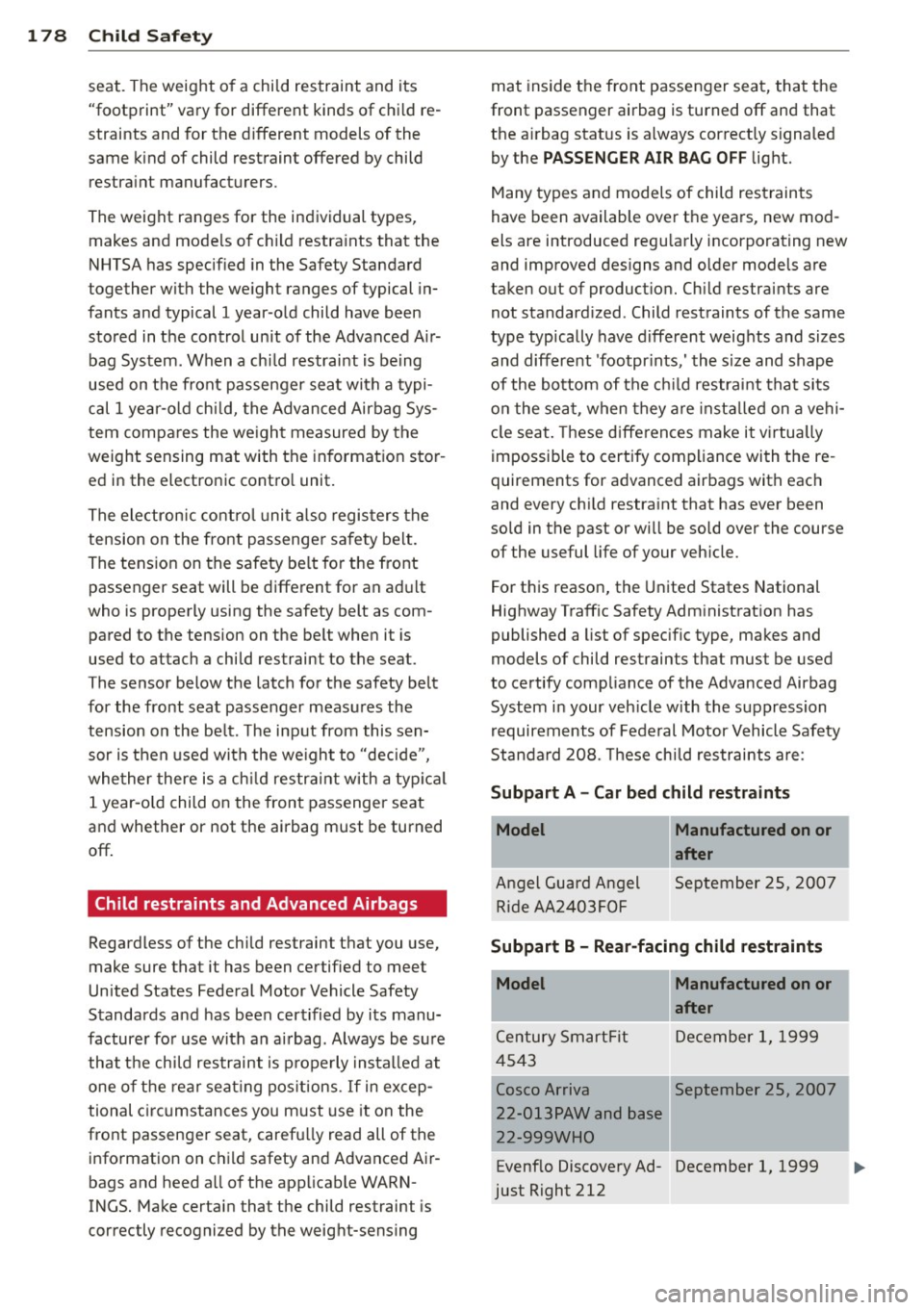
178 Child Saf ety
seat. The weight of a child restraint and its
"footprint" vary for different kinds of chi ld re
straints and for the d ifferent models of the
same kind of child restraint offered by child
restra int manufacturers.
The weight ranges for the individual types,
makes and mode ls of ch ild restra ints that the
NHTSA has specified in the Safety Standard
together with the weight ranges of typical in
fants and typical 1 year-old child have been
stored in the control unit of the Advanced A ir
bag System. When a ch ild restrai nt is being
used on the front passenger seat with a typi
cal 1 yea r-old ch ild, the Advanced Airbag Sys
tem compares the we ight measured by the
weight sensing mat with the in formation stor
ed in the electronic control unit.
The ele ctron ic cont rol unit also registers the
tension on the front passenge r safety belt.
The tension on the safety be lt fo r the front
passenger seat will be different for an ad ult
who is properly using the safety belt as com
pared to the tension on the belt when it is
used to attach a child restraint to the seat.
The sensor below the latch for the safety belt
for the front seat passenger measu res the
tension on the be lt. The input from this sen
sor is then used with the we ight to "decide",
whe ther there is a ch ild restraint w ith a typ ica l
1 year-o ld child on the front passenger seat
and whether or not the airbag must be turned
off .
Child restraints and Advanced Airbags
Regardless of the child restraint that you use,
make sure that it has been certified to meet
United States Federal Motor Vehicle Safety
Standards a nd has been certified by its manu
facture r fo r u se w ith an airbag. Always be s ure
that t he ch ild res traint is p rope rly insta lled at
one o f th e rear seat ing pos itions. If in excep
tional c ircu mstances you must use it on the
front passenger seat, caref ully read all of the
info rmation on c hild safety and Advanced Air
bags and heed all of the applicable WARN
INGS. Make certain that the child restraint is
correctly recognized by the weig ht-sensing mat
inside the front passenger seat, that the
front passenger airbag is turned off and that
the a irbag stat us is always cor rect ly signa led
by the
PASSENGER AIR BAG OFF light.
Many types and models of child res traints
have been available over the years, new mod
els are introduced regu larly incorporating new
and improved des igns and older models are
taken out of product ion. Ch ild restraints are
not standard ized . Child restraints of the same
type typically have d ifferent weights and sizes
and diff erent 'footpr ints,' the s ize and shape
of the bo ttom of the ch ild restra int that sits
o n t he seat, when they a re inst alled on a vehi
cle sea t. Th ese d ifferences make it vir tually
impossible to certify compliance with the re
quirements for advanced airbags with eac h
and every child restra int that has ever been
sold in the past or will be sold over the course
of the useful life of your veh icle.
For th is reason, the United States National
Highway Traffic Safety Adm inistrat ion has
published a list of specific type, makes and
models of child restraints that must be used
to certify comp liance of the Advanced Airbag
System i n your veh icle w ith the suppression
requirements of Federal Motor Vehicle Safety
Standa rd 208. These chi ld restraints are:
Subpart A - Car bed child restraints
Model
Angel Guard Angel R ide AA 2403FOF
Manufactured on or
after
September 25, 200 7
Subpart B - Rear-facing child restraints
Model Manufactured on or
after
Century SmartFit Dece mber 1, 1999
4543
Cosco Arriva September 25, 2007
22-013PAW and base
22-999W HO
Evenf lo Discove ry Ad -December 1, 1999
just Right 212
I
....
Page 202 of 318

200 Intelligent technology
-ABS and ASR on ly work correctly when
all four wheels are equipped w ith ident i
ca l tires. Different tire s izes can lead to a
reduction in engine power.
- You may hear noises when the systems described are working.
- If the indicator light
DJ or m:11 (USA
models) ;tiJ (Canada models) appears,
there may be a malfunct ion
c::;, page 19,
c::;, page 18 .
Switching on and off
ESC turns on automatically when you start
the engine.
Fig. 188 Center console w ith ESC OFF button
Switching ASR off (sport mode)
In certain situat io ns, you can switch ASR and
ESC into sport mode by pressing the button
l!l
c::;, fig. 188. The indicator light II comes on
and the mess age Stabilization control (ESC ):
Off warning! Reduced stability appears. ASR
deactivates completely and the assistance provided by the ESC system is limited. Switch
to sport mode on ly when your driving skills,
traffic and weather cond itions permit .
I n some situations, it may be useful to switc h
ASR off to let the wheels slip. Example:
- Rocking the vehicle back and forth when it is
stuck
- Driving in deep snow or on loose ground
- Driving with snow cha ins
Switching ASR on Press the button[!] aga in. The message Stabi
lization control (ESC): On appears.
A WARNING
- Drive whee ls can sp in and you can lose
control of the vehicle more eas ily when
ASR and ESC are in sport mode, especial
ly when the road is slippery.
- Sw itch to sport mode only when your
driving skills, traff ic and weather condi
tions permit.
@ Tips
You cannot sw itch sport mode on when
adaptive c ruise control* is working.
Braking
General information
What affects braking efficiency?
-
Operating conditions and driving habits
The brakes on today's automobiles are still
subject to wear, depending largely on operat
ing condit ions and driving habits
c::;, &. . On
vehicles that are either dr iven mostly in stop
and-go city traffic or are driven hard, the
brake pads should be checked by your author
ized Audi dea ler more often than specified in
the Warranty
& Maintenance booklet. Failure
to have your brake pads inspected can result
in reduced brake performance.
On steep slopes, you should use the braking
effect of the engine. This way, you prevent un
necessary wear on the brake system. If you
must use your brakes, do not hold the brakes
down continuously. Pump the brakes at inter
vals .
Operating noise
Noises may occur when braking depending on
the speed, braking force and outside condi
tions such as temperature and humidity.
Due to the nature of the materia ls used in ce
ramic brake rotors*, noises may become more
apparent at low speeds. .,..